Archived Fire Damage Blog Posts
Fire Devastates Mobile Home
3/5/2025 (Permalink)
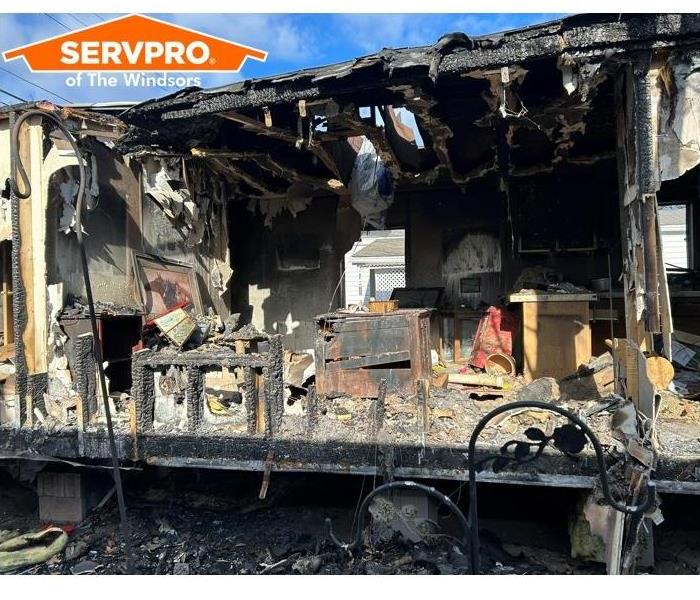 Here's an inside look of the devastation of a mobile home after the fire.
Here's an inside look of the devastation of a mobile home after the fire.
Recently, our team was called to a local mobile home park after a devastating fire left a structure completely destroyed. The damage was so severe that the entire structure, along with all its contents, was beyond repair. Our team was tasked with the breakdown and disposal of the property.
Our first step was working with local officials to get the necessary clearances and permits. We made sure everything was in line before moving forward, ensuring compliance with town regulations. Once we had the green light, our team jumped into action. Our skilled team worked diligently to first retrieve the only salvageable item- a cherished table before we began to carefully dismantle the entire structure, piece by piece. After a few days and numerous dumpsters, we completed the job.
Although the property owner experienced a tremendous loss, this process has allowed them to begin moving forward and start rebuilding.
We understand that situations like this are incredibly stressful, and we're here to offer our support during these challenging times. Handling unique circumstances is something we do every day, and we’re always ready to assist, no matter the challenge. If you’re facing a difficult situation, we’re here to help. You can count on us to approach it with professionalism and a commitment to quality.
Smart Toaster Starts Fire in South Windsor!
4/9/2024 (Permalink)
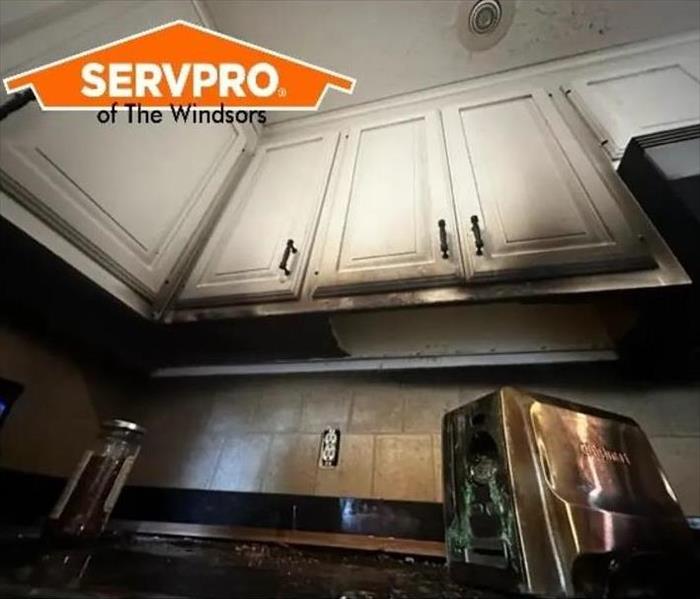 Here we see the damage caused by the toaster and what was left of it after the fire!
Here we see the damage caused by the toaster and what was left of it after the fire!
In recent years, smart appliances have changed the way we interact with everyday household devices. From Amazon’s Alexa to refrigerators to washing machines, thermostats and everything else, these devices offer a range of benefits that enhance convenience, efficiency, and even safety in our homes. While the benefits of smart appliances are substantial, it's essential to acknowledge that connectivity can also introduce unique risks.
Recently, a South Windsor homeowner suffered a house fire caused by a smart toaster. The family had recently added smart appliances to their kitchen. The toaster boasted customizable toasting settings and remote control via a mobile app. One morning, the family received a notification via phone indicating the toaster had encountered an error. However, a few minutes later, a neighbor noticed smoke coming from the kitchen.
Fortunately, the homeowner was able to react quickly to extinguish the fire and mitigate the damage. While the family avoided totally catastrophe the home sustained smoke damage throughout all three levels and the kitchen was charred. Fortunately, noone was hurt and the property can be restored.
This cautionary tale underscores the importance of exercising caution and vigilance when integrating smart technology into our homes. While smart appliances have many benefits it is important to monitor the devices and maintain an emergency response plan for your home and family.
SERVPRO of The Windsors is performing the fire remediation and will also assist the homeowners with their reconstruction. We understand the hardships after a home fire and will work will property owner to ease difficulty navigating remediation work. If you need us, we are just a call away. Keep an eye on our blog to watch this project unfold.
Home Fire In Windsor Locks, CT
4/5/2021 (Permalink)
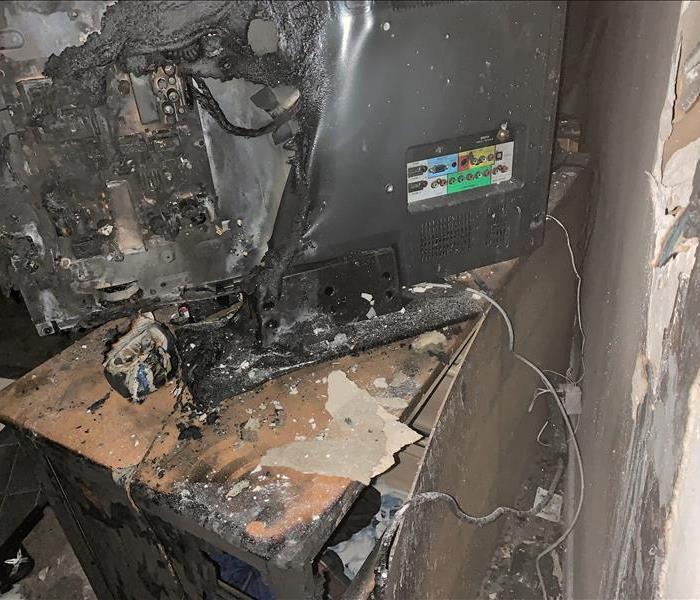 Here's the television that caused the fire! Scary! Luckily no one was injured.
Here's the television that caused the fire! Scary! Luckily no one was injured.
Working in this industry makes you a little more receptive to an emergency plan, Like the ambulance worker who never goes without a seatbelt because of what they’ve seen, we are especially cautious when it comes to home threats and property damage.
However, even with heightened awareness there are always weird and unpredictable incidents. This week our team received another unique fire loss. A home in Windsor suffered a home fire caused television which went up in flames while our customer was in their bed fast asleep.
As a mother, I’ve thought long and hard about how careful we are to mind our children. In the home we are mindful to the threats in the kitchen, around pools, or electrical sockets, etc., but a television catching fire and then the fire spreading throughout the home?! Who could ever anticipate that? The tv was an anomaly; so how can one possibly be prepared for a scenario like this? The frightening truth is there are not much proactive measures you can take other than to make sure your electronics are in functioning condition and the wires are intact.
Unfortunately, we cannot anticipate every threat so prepare your family with an emergency response plan. Be prepared to respond; have a plan of action. Talk to your little ones today, have a meeting point, and an emergency escape plan that you and your family practice at least once a year, if possible, twice! Make sure your children know emergency numbers and when and why to dial 911, have fire extinguishers and alarms functioning in place throughout the home that you test regularly. Be well friends!
What Is A Puff Back?
3/30/2021 (Permalink)
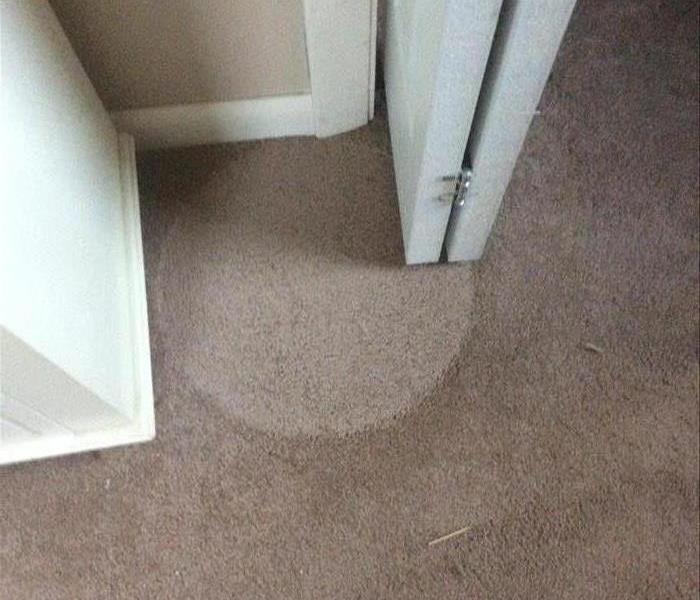 The circle shows the unaffected portion of the carpet as it was covered by a piece of furniture. The remaining area is affected by soot damage.
The circle shows the unaffected portion of the carpet as it was covered by a piece of furniture. The remaining area is affected by soot damage.
What is a puff back you ask? Great question! The term is industry jargon and not universally recognized. A puff back happens when upon starting a heating system, the system misfires and releases smoke and soot particles throughout the entire system and then into the property. Puff backs can happen with both oil and gas type furnaces, boiler units, and water heaters alike. When a heating system misfires soot and smoke particles are released infiltrating all of the surface areas and belongings in the given space. A puff back is one of the leading causes for fire remediation and remediation for this type of loss is elaborate, extensive, timely, and costly. Be sure to have your system regularly given maintenance to avoid a puff back and if you do experience a puff back on your property and need assistance navigating uncharted waters, we can help.
Understanding Fire Damage-Smoke vs. Soot
12/18/2020 (Permalink)
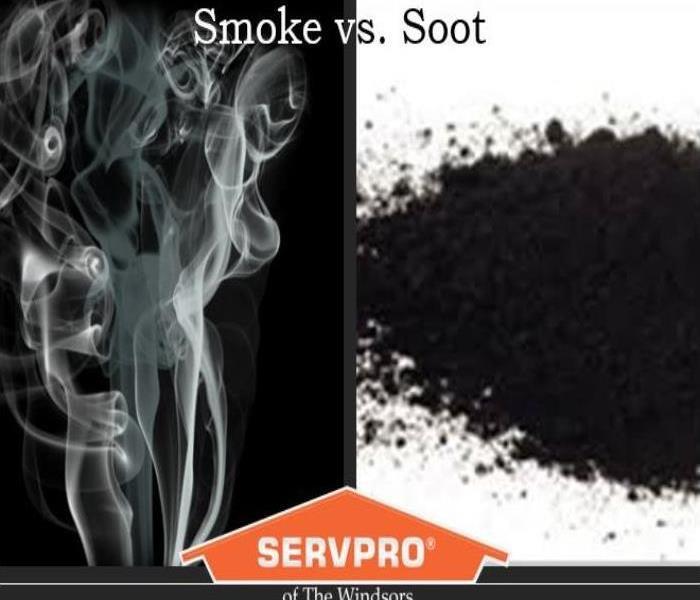 Smoke vs Soot-Do you know the difference?
Smoke vs Soot-Do you know the difference?
When we talk about fire damage, people often have misunderstandings. After a property suffers a fire there can be a variety of secondary damage. The damage often includes water damage, caused by the extinguishing of the fire and a combination of smoke and soot damage. People commonly mistake soot and smoke as the same things, they are not. Continue reading to learn more about smoke and soot.
Smoke – Smoke is the result of combustion. Smoke contains solids, liquids and gases. If
smoke contains hot oils, which are cooled rapidly, they can form a film on surfaces that can be difficult to remove.
Soot – Soot is the solid residues as a result of combustion. Soot is the part of the material that did not burn, called the product of incomplete combustion.
If your home suffers from smoke or soot damage, we can help. Call us today for your emergency needs or an obligation free consultation.
Fire is Terrifying.
12/13/2020 (Permalink)
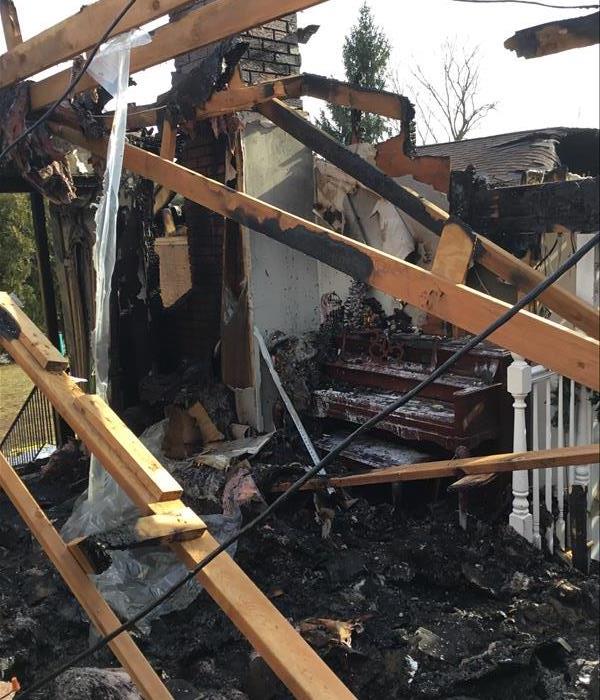 The aftermath of a recent house fire.
The aftermath of a recent house fire.
Fire is terrifying. Complete destruction, homes and buildings burned to the ground can be achieved in mere minutes. Frankly, it is terrifying. Just this week we responded to a devastating home fire. Here we are in the middle of a pandemic, holiday season, and this poor family has lost their refuge and every material possession they owned. Everything in a matter of minutes.
This particular fire was caused by a chimney and out of the family’s control. Which reminds us we cannot control everything. So, while we must practice fire safety and work to prevent home fires, we must also prepare for the aftermath of a home fire. We must be proactive and prepared to be reactive.
At the very minimum take these precautions to prepare yourself.
-Keep fire extinguishers in your home.
-Have an evacuation plan (practice with your children!)
-Have an emergency plan
-Maintain insurance coverage
The thought of a home fire is scary but less so when we have a response plan in place. We wish you and your family a safe and happy holiday season.
Do You Know How to Use a Fire Extinguisher?
12/2/2020 (Permalink)
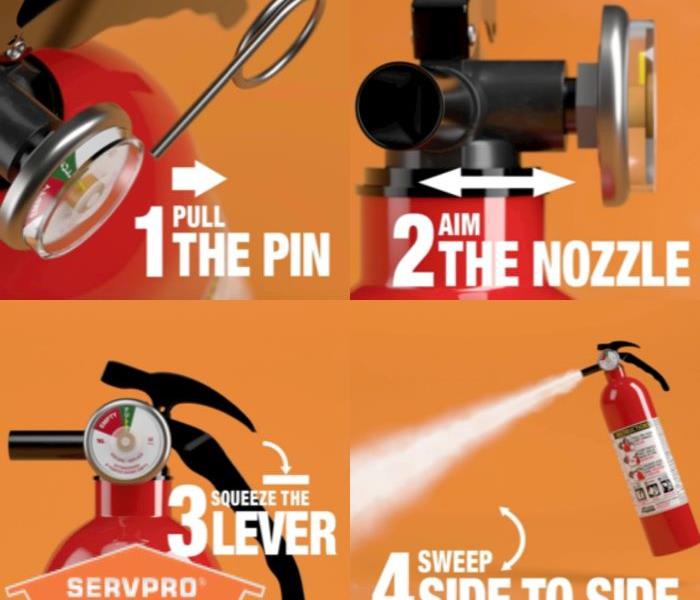 Master fire extinguisher use with these four easy steps!
Master fire extinguisher use with these four easy steps!
From a young age we are taught that if you play with fire you will get burnt. We are taught fire safety and protocols in case you ever have the misfortune of being in a fire yourself. Who remembers STOP, DROP, & ROLL.
What we aren’t taught is how to properly use a fire extinguisher. We all have seen fire extinguishers; we know what they are, but how many people know how to use them? This knowledge is crucial so that you’re able to contain and extinguish a fire. Well luckily for you we are here to help…. Here are the four steps to correctly using a fire extinguisher. Before beginning with the steps remember, DO NOT PANIC!
- Pull the Pin.
- Aim the nozzle at the base of the flame. (Hitting the tops of the flame will not be effective)
- Squeeze the trigger firmly in a controlled manner, in order to release the agent.
- Sweep (using the nozzle) from side to side until the fire is put out.
Christmas Tree Fire Prevention
12/1/2020 (Permalink)
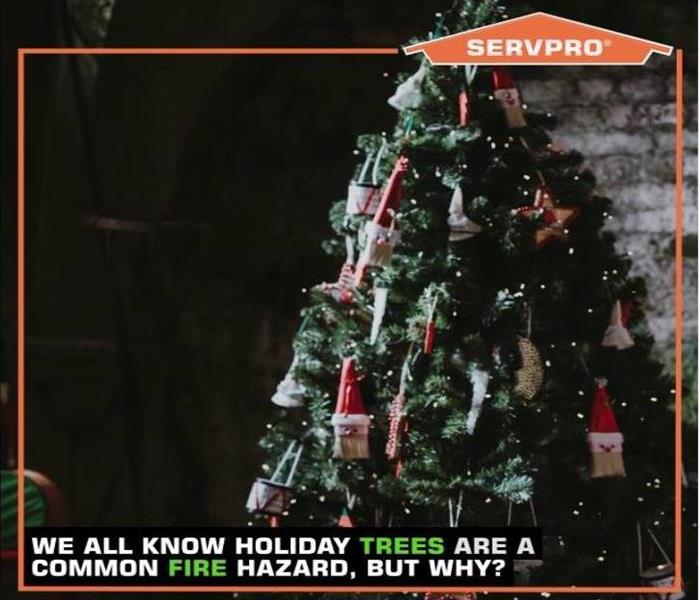 Don't let the joy of the holiday season be interrupted by a fire!
Don't let the joy of the holiday season be interrupted by a fire!
It’s the most wonderful time of the year! Food, presents, festivities, time off from work! So many great things to look forward to during the holiday season. Did we mention the decorations! I love Christmas décor! Wreaths, garland, sparkle, snowflakes, reindeer, Santa, ahh I love it all! Let’s not forget the crème de la crème, the Christmas tree! So many options 8 foot or 3?! White or green?! Minimal décor or an abundant amount? Besides it’s religious symbolism the Christmas tree is a representation of expression and creativity! While there is much to appreciate about the Christmas tree, they are not without risks. So, from your friends at SERVPRO of The Windsors here are some helpful tips to keep your Christmas Tree safe!
- Place the tree away from heat threats-fireplaces, candles, lights.
- Keep real trees watered.
- Do not add chemicals to help with the hydration.
- Turn your lights off nightly.
- Make sure lights and other electrical decorations are free of defects and in good working condition.
- Avoid overloading electrical sockets.
- Decorate the lower part of the tree with pets and small children in mind.
SERVPRO of The Windsors Goes Above and Beyond
11/26/2019 (Permalink)
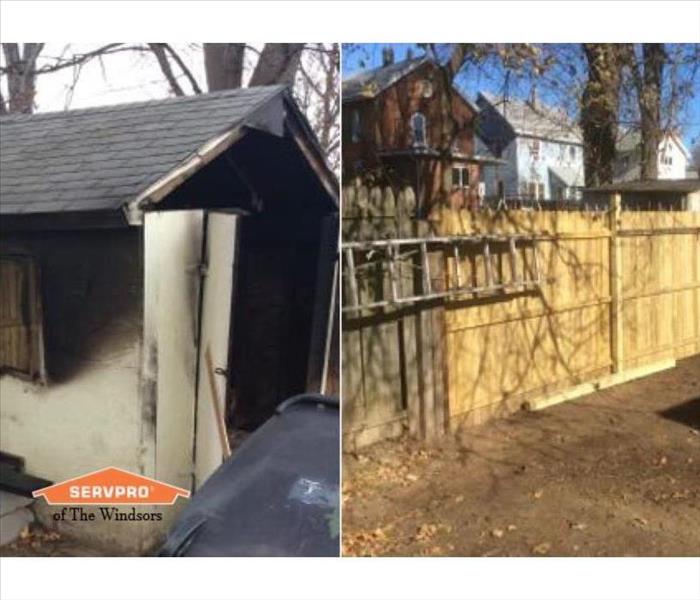 Before and After of Shed Fire!
Before and After of Shed Fire!
As seen in the before photo this shed is the aftermath of a fire, the cause of which remains unknown. Our office received the call for this loss and responded immediately. The customer requested that we remove and discard of the shed and the lawn equipment it contained. Upon completion of removing the shed, one of our team members noticed that the fence too had been affected by the fire. He also noticed that our customer was a dog owner and the fence which was currently being patched up with plywood would not suffice in safely keeping our customers' furry friends in his yard so without being asked Jose went ahead and repaired our customers shed. Here at SERVPRO of The Windsors, we put our customers and their needs first and this very demonstration proved just that to be oh so true!
T.U.R.K.E.Y Safety Tips!
11/25/2019 (Permalink)
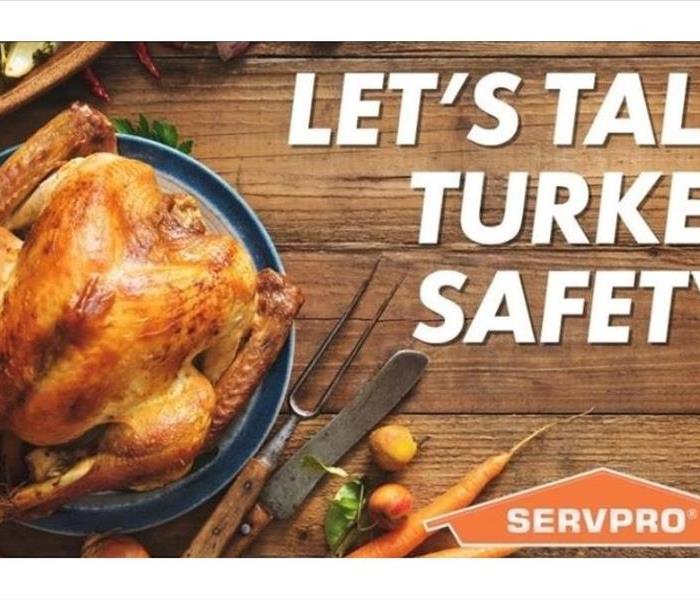 Talk Turkey Safety With SERVPRO of The Windsors!
Talk Turkey Safety With SERVPRO of The Windsors!
Thanksgiving … a day of gratitude, family, and feasting…what’s not to enjoy! We have come up with a few tips to help keep you and your family safe while preparing your meal! Avoid holiday upset by practicing fire safety this holiday season!
Thaw your turkey safely by placing it in a leak-proof plastic bag in a sink full of cold water (replacing the water every 30 minutes)
Use different cutting boards and utensils for meats and vegetables to avoid the risk of cross-contamination.
Remember your oven should never be below 325?? F when cooking a turkey, to ensure your turkey cooks evenly and any harmful bacteria have been destroyed.
Keep a fire extinguisher handy and all smoke detectors functional.
Ensure someone remains in the kitchen when food is actively cooking.
Youngsters and pets should be kept at least 3 feet away from all hot surfaces!
Most importantly have fun & cherish these moments as a family together. Be grateful & enjoy your feast!
Fire Safety & Readiness Quiz
10/29/2019 (Permalink)
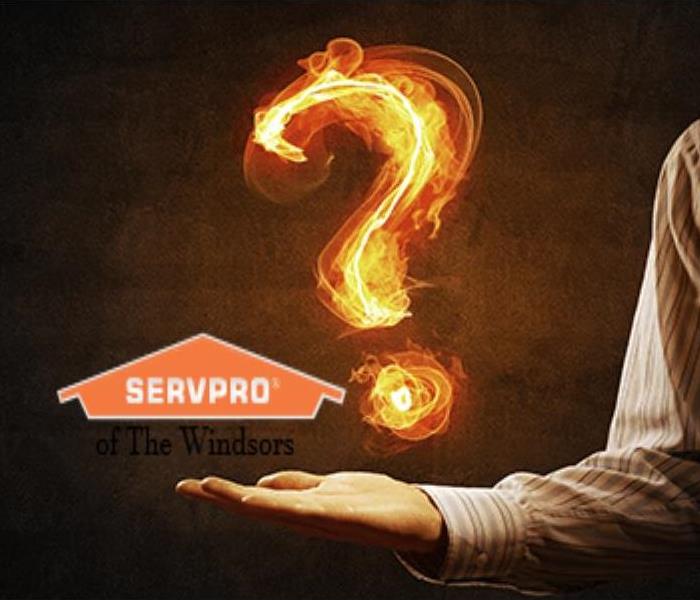 Let SERVPRO of The Windsors be your go to remediation company, we make things "Like it never even happened".
Let SERVPRO of The Windsors be your go to remediation company, we make things "Like it never even happened".
Are you prepared for a fire? Do you have a basic understanding of how to avoid house fires and what to do in the case you or your loved ones befall such a tragedy? Ask yourself these few questions to see if you are prepared and get a better understanding of what you need to do to prepare yourselves better. (You can find the correct answers at the end…. Don’t Cheat!)
1. What is one of the leading causes of house fires?
- A. Children
- B. Arson
- C. Smoking
2. About how many people die per year from house fires in the US?
3. Put the steps in the correct order for how to properly put out a fire with a fire extinguisher
- A. Leave immediately if you’re unable to extinguish the fire
- B. Sweep hose from side to side
- C. Squeeze the lever
- D. Pull the pin
- E. Replace or recharge your fire extinguisher as soon as possible
- F. Back away and repeat if the flames flare-up
- G. Aim the hose at the base of the fire
4. Approximately how much does the US spend on fire damage annually?
- A. 1 Billion
- B. $800,000
- C. $6.7 million
5. What do you do in the event that an article of clothing on your person catches fire?
- A. Stop, Drop, & Roll
- B. Find water & try to put yourself out
- C. Do the hokey pokey
6. What do you do after a fire has occurred and the dust has settled?
- A. Take a nap
- B. Call SERVPRO of The Windsors to assist with cleaning & repairs
- C. Clean up yourself
As always, we hope you have found this information helpful and inspiration to prepare yourself if you’re interested in learning more about fires how they are started and how to be prepared check out the rest of our series on fire safety and readiness. Remember having an emergency plan is one of the best ways to keep yourself and your loved ones safe!
Answer Key:
- C
- A
- D, G, C, B, F, A, E
- C
- A
- B
Common Causes of House Fires, Part III
10/27/2019 (Permalink)
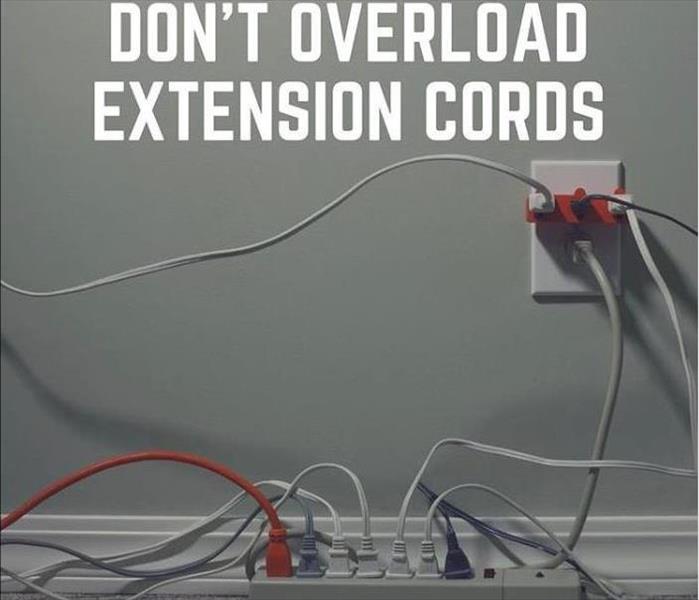 Keep safe by avoiding misuse of extension cords and outlets!
Keep safe by avoiding misuse of extension cords and outlets!
We’re back with Common Causes of House Fires, Part III! Today we are talking about fires caused by misuse of electrical cords and outlets. The U.S. Fire Administration says that Americans experience 25,000 electrical fires a year with Two-thirds of all electrical fires begin in plugs or cords. Sadly, many of those fires happening during the holiday season. Follow these best practices to keep you, your family, and your home safe.
Best Practices:
- Inspect electrical cords and outlets at least once a year
- Tip: Warning signs include: flickering lights, buzzing sounds, odor
- Replace any frayed or damage cords, even if damage appears minimal
- Limit number of appliances to 2 per cords and outlets
- Do not “piggyback” cords
- Do not place extension cords under rugs
- Do not remove the third prong to fit into a two-prong outlet
- Avoid using extension cords for space heaters and air conditioners
We hope that you have found this information helpful. Please take extreme care when you are smoking and using candles. Remember to stay attentive, use caution, and follow these safety tips.
While we all hope for the best and cannot imagine a fire happening the reality is it happens more often that we want to recognize. Hope for the best, plan for the worst. So be sure to 1. Have plenty of smoke alarms in your home and 2. have an emergency escape plan.
If the unthinkable happens it is important to react safely and quickly. Here’s what to do:
- Get out! If possible close the door behind you when you leave to help contain the fire.
- Call 9-1-1, wait for emergency responders, do not attempt to put the fire out by yourself.
- Call your homeowner's insurance company to begin the claim process.
- Call SERVPRO of The Windsors for an emergency response, we’ll walk you through the rest.
Fire Damage Dictionary!
10/24/2019 (Permalink)
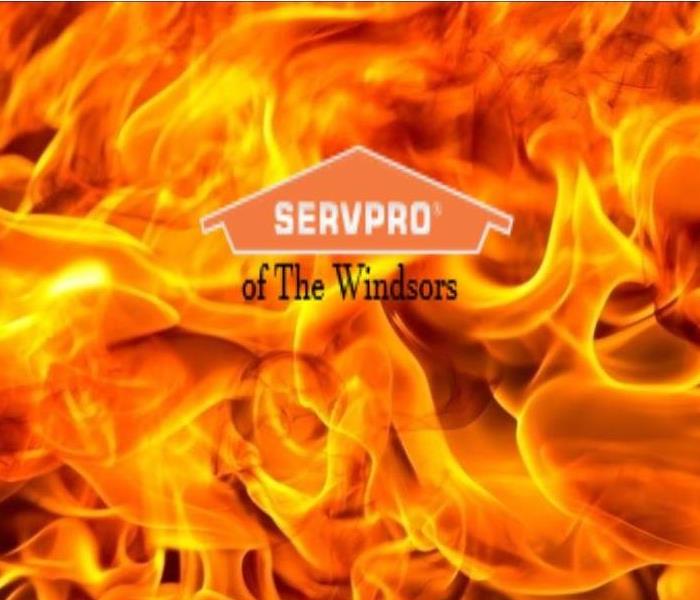 SERVPRO of The Windsors understands fire damage!
SERVPRO of The Windsors understands fire damage!
SERVPRO of The Windsors has extensive experience with fire damage, but for those who don't, we have created this Fire Damage Dictionary to offer a better understanding to the most common terms associated with fire damage.
Deodorization – The process of neutralizing malodors
Deodorizers – Masking agents that overpower malodors with a more pleasant odor.
Filtration equipment-Equipment designed to filter odor particles from the air.
Mitigation services –. Mitigate means to “stop the damage”. SERVPRO is a mitigation company offering mitigation services for fire restoration. Common mitigation services include board ups cleaning and treating property and belongings, deodorization, and rebuild services.
Ozone – An electronically powered device called an ozone generator and is used for odor control. Ozone breaks down or oxidizes natural rubber and elastic.
Smoke – Smoke is the result of combustion. Smoke contains solids, liquids, and gases.
Soot – Soot is the solid residues as a result of combustion. Soot is the part of the material that did not burn, called the product of incomplete combustion.
Thermal fogging –The use of heat to produce a dry deodorant fog using a piece of equipment called a thermal fogger.
ULV Fogger – An electronically powered device with a nozzle attached to a hose used to apply solutions on a microscopic size.
Wet Cleaning – A cleaning technique using a circular, overlapping motion.
Methods and Types of Deodorization
10/18/2019 (Permalink)
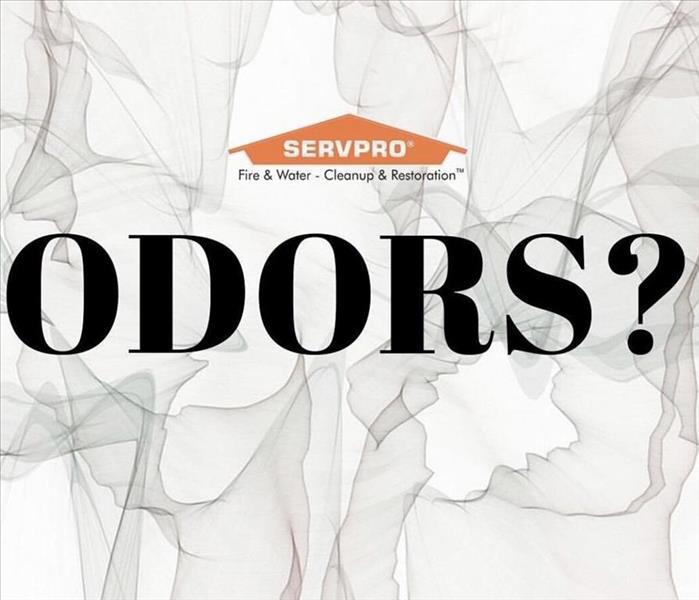 If you need to combat an odor, we can help!
If you need to combat an odor, we can help!
After a fire your home will likely have an intense odor. How do we combat that odor you ask? Well, our method varies from project to project. In different situations, we find different methods more effective. For best results on heavy smoke odors, a combination of techniques should be used. Continue reading to learn about the different methods and types of deodorization.
The process to follow to deodorize most situations is:
- Remove the source
The very first thing we need to do to begin fire remediation is to remove the source. If you had a stove fire for example, we need to move the stove out of the property. We can store the source if needed, our crew will also take pictures and documentation to assist with your claim process.
- Clean the residues
After a fire, smoke and soot particles and odors are going to be abundant and will contribute to the malodor. A thorough cleaning of all surfaces will be necessary. Our technicians are equipped with the training and products to clean all your items with the unique method and product best suited to clean the material.
- Neutralize the odor
After a fire, odors are going to be intense and will need some method of odor neutralization. Most deodorizers we use for fire remediation are a combination of masking and pairing agents. Masking agents are designed to overwhelm a malodor. Pairing agents are designed to bond with odor particles and create odorless particles. Absorption agents are designed to absorb the odor particle. Air scrubbers in conjunction with HEPA filters, are designed to filter odor particles from the air.
We may also do some form of fogging. Fogging is another method used to neutralize malodors. There are 3 different types of fogging. Ozone, thermal fogging, and ULV fogging. Ozone is an oxidizing agent and breaks down or oxidizes natural rubber and elastic. Thermal fogging uses heat to produce a dry deodorant fog called a thermal fogger. ULV fogging uses an electronically powered device that usually has a nozzle attached to a flexible hose and is used to apply solutions down to a microscopic level.
- Seal the surface
Sealing is used to seal odor molecules which prevents them from going air is used to seal in odor molecules to prevent them from becoming airborne. A sealant is used on walls and ducts.
If you’ve experienced a fire or need to combat malodors, we are just a phone call away. Call us for your deodorization needs today at 860-627-0763!
Common Causes of Home Fires, Part I
10/17/2019 (Permalink)
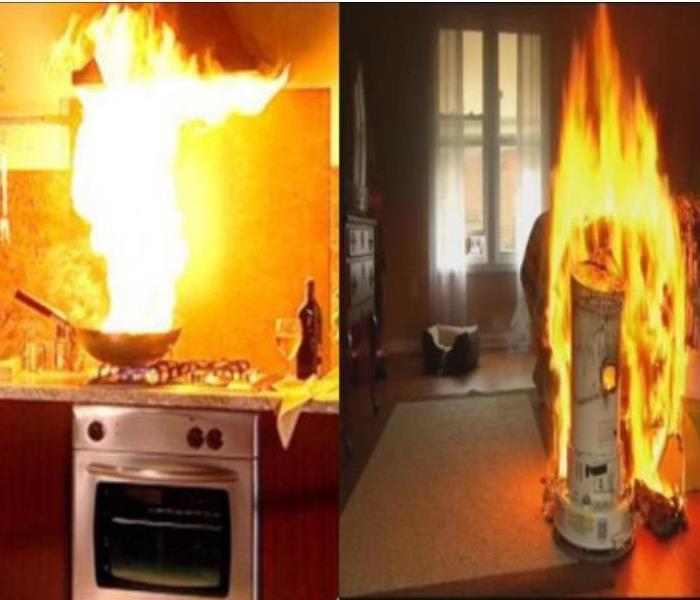 Take caution to avoid fires being ignited by cooking and space heaters!
Take caution to avoid fires being ignited by cooking and space heaters!
Fires are devastating! The good news is many fires are avoidable and preventable. Two of the most common causes of home fires are cooking errors and portable heaters. Continue reading to learn how these fires are ignited and some tips on how to avoid them.
Cooking Equipment:
Cooking fires are most often caused by unattended cooking. Never leave food cooking unattended, stay in your kitchen when frying, grilling, or boiling food. Even if you will be “just a minute” the risk is too great! Never leave food cooking unattended! Two-thirds of cooking fires start are ignited by food and/or cooking materials.
Best Practices:
- Stay present while cooking.
- Ask someone to watch the equipment while you leave the room.
- Don’t cook if you are tired or intoxicated.
- Turn it off and double-check it!
- Annual inspections on your appliances to ensure they are functioning properly.
- Keep your cooking equipment and appliances clean.
Portable/Space Heaters:
Portable space heaters most commonly catch fire when they come into contact with other household items, commonly things like curtains, blankets, and carpet. Space heaters can also overheat easily & catch fire.
Best Practices:
- Maintain 3 ½ ft between your portable heater and flammable objects!
- Unplug, when you are leaving the room or home, or the heaters are not in use
- Keep out of reach of children and pets!
- Place flatly
- Inspect heaters every few months to ensure they are in good working condition ie: no broken plugs or damaged wires
- Plug heaters directly into an outlet, avoid extension cords
We hope that you have found this information helpful. Please take extreme care when you are cooking and using space heaters. Remember to stay attentive, use caution, and follow these safety tips.
While we all hope for the best and cannot imagine a fire happening the reality is it happens more often than we want to recognize. Hope for the best, plan for the worst. So be sure to 1. Have plenty of smoke alarms in your home and 2. have an emergency escape plan.
If the unthinkable happens it is important to react safely and quickly. Here’s what to do:
- Get out! If possible close the door behind you when you leave to help contain the fire.
- Call 9-1-1, wait for emergency responders, do not attempt to put the fire out by yourself.
- Call your homeowner's insurance company to begin the claim process.
- Call SERVPRO of The Windsors for emergency response, we’ll walk you through the rest.
Common Causes of Home Fires, Part II
10/17/2019 (Permalink)
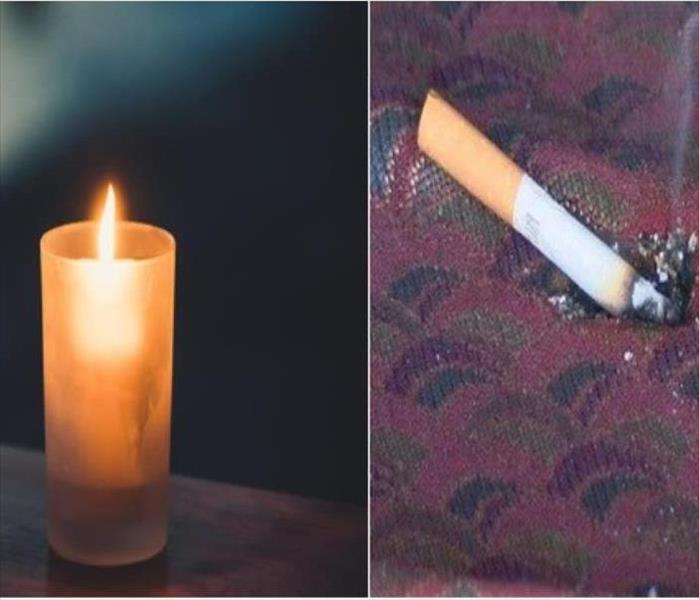 Take caution to avoid fires caused by smoking and candles!
Take caution to avoid fires caused by smoking and candles!
Welcome back! We’re glad you are here! We are back with 2 more of the most common cause of house fires! The next two we want to discuss are home fires that are attributed to candles and smoking. Continue reading to learn how these fires are ignited and some tips on how to avoid them.
Candles
We love candles! They look and smell pretty! Behind the beauty though is a great threat. If left unattended, candles can easily cause a room to burst into flames. Make sure you are constantly monitoring your lit candle!
Best Practices:
- Keep out of reach of children and pets!
- Place flatly on stable heat resistant surfaces.
- When lighting a candle long-reach lighter to keep your hair and clothing away from the flame.
- Keep them away from the flammable materials
- Always blow them out carefully before leaving a room
Smoking
Home fires caused by smoking are usually the result of carelessness or improper disposal. When cigarettes or other smoking materials aren’t put out properly the butts can stay lit for hours. If these lit cigarette butts encounter flammable materials results can be fatal.
Best Practices:
- Always fully put out your cigarettes.
- Use an ashtray.
- Avoid smoking when tired or intoxicated.
- Avoid smoking in bed.
We hope that you have found this information helpful. Please take extreme care when you are smoking and using candles. Remember to stay attentive, use caution, and follow these safety tips.
While we all hope for the best and cannot imagine a fire happening the reality is it happens more often that we want to recognize. Hope for the best, plan for the worst. So be sure to 1. Have plenty of smoke alarms in your home and 2. have an emergency escape plan.
If the unthinkable happens it is important to react safely and quickly. Here’s what to do:
- Get out! If possible close the door behind you when you leave to help contain the fire.
- Call 9-1-1, wait for emergency responders, do not attempt to put the fire out by yourself.
- Call your homeowner's insurance company to begin the claim process.
- Call SERVPRO of The Windsors for an emergency response, we’ll walk you through the rest.
Types of Fires and Extinguishers!
10/25/2018 (Permalink)
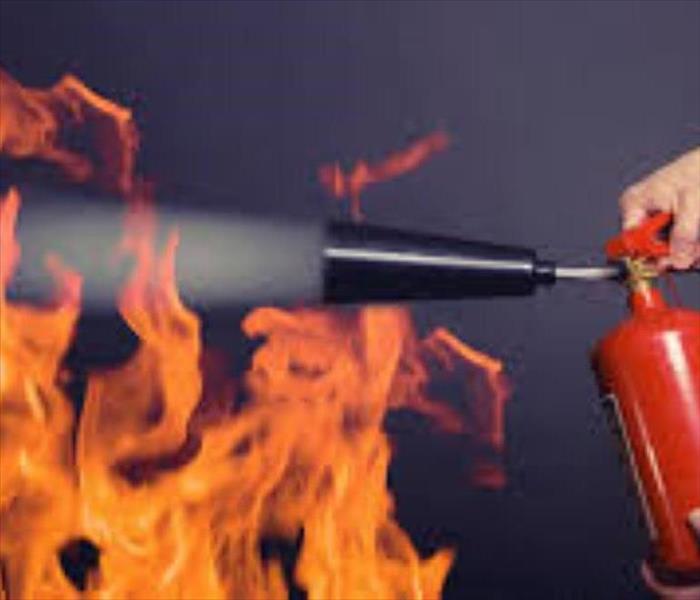 Be sure to keep a proper fire extinguisher handy!
Be sure to keep a proper fire extinguisher handy!
A fire is a dangerous situation that can quickly become out of control. The first line of defense in battling the flames is a fire extinguisher, but did you know that there are different types of extinguishers for different fires? Hopefully you never encounter such a situation, but knowing the source and having the proper equipment is one easy way to prepare.
The Five Classes of Fires
The National Fire Protection Association has created a standard known as the NFPA 10 for portable fire extinguishers.
Class A fires group ordinary combustibles such as wood, paper, cloth, rubber, and plastics.
Class B fires are any flammable liquids such as gasoline oils, solvents, and alcohol. Flammable gases like propane are also under this class.
Class C fires involve any energized electrical equipment like computers or appliances.
Class D deals with combustible metals like magnesium, sodium, lithium, and potassium.
Class K fires specifically group liquid fires involving cooking oils and greases.
Types of Extinguishers
You need the right tool for the job, and fire extinguishers are no different. Knowing which extinguisher fights which fires best is essential to stop the fire from spreading or re-igniting.
Water and Foam: To be used for Class A fires only. Never use on Class C fires as it can create a shock hazard!
Carbon Dioxide: Can be used for Class B and Class C.
Multi-Purpose Dry Chemical: For use on Class A, B, and C fires. This is the most widely used type of extinguisher.
Ordinary Dry Chemical: For Class B and C fires only. Using an ordinary dry chemical extinguisher on a Class A fire can cause it to re-ignite even if it appears to be fully out.
Wet Chemical: For Class K fires and some Class A fires. These were developed specifically for cooking incidents.
Clean Agent/Halogenated: Effective for Class A, B, and C, though smaller clean agent extinguishers may not be rated for Class A fires.
Dry Powder: Similar to dry chemical, but for Class D fires only.
Water Mist: For use with Class A or C fires where contamination is a concern.
Multi-Purpose Cartridge Operated Dry Chemical: Similar to regular dry chemical extinguishers and can tackle Class A, B, and C fires.
Ordinary Cartridge Operated Dry Chemical: For Class B and C only.
Remember that a portable fire extinguisher is only meant to put out a fire of limited size. If you feel that you are in danger or are not confident in using equipment, leave the area and call 911.
In The News!!
11/14/2016 (Permalink)
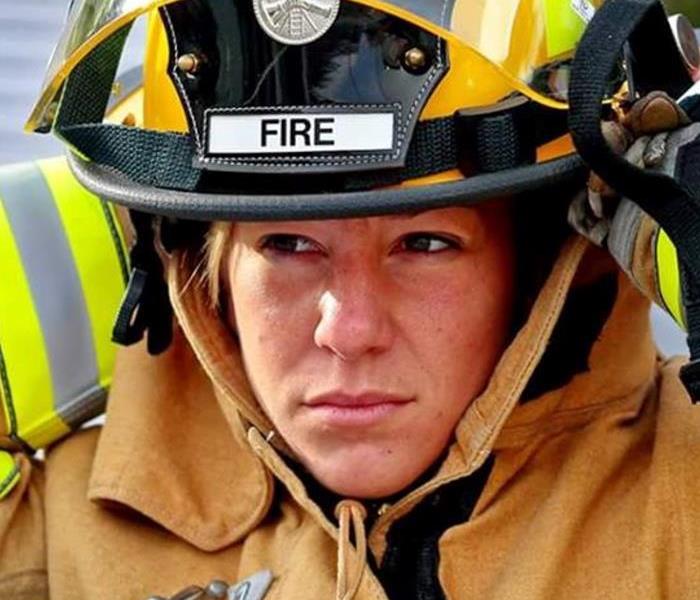 Thank you to all of our emergency responders!
Thank you to all of our emergency responders!
Looking for a Great Holiday Gift Idea? Give Your Family a Fire Safety Plan
Local SERVPRO® restoration specialist highlights the difference between fire prevention planning with fire safety planning
The holidays are approaching and many families are finalizing plans for elaborate meals, get-togethers with friends, and decorating with festive lights. Amidst all this planning, Antonio Senese of SERVPRO® of The Windsors reminds homeowners that they may be overlooking the most important plan they can make—a fire safety plan.
“Each year, statistics show the incidence of home cooking and candle fires peaks during the holiday season. This tends to focus homeowners on fire prevention precautions—and that’s a good thing,” said Senese. “But to truly protect your family from the dangers of a home fire, at the holidays and throughout the year, you need to start with a fire safety plan. Developing a fire safety plan and practicing it regularly with your family is the most important step you can take to help prevent a house fire from turning into a devastating tragedy.”
SERVPRO is a national leader and provider of fire and water cleanup and restoration services, and their disaster response professionals know from experience how devastating a home fire can be. They also know that when fire causes a loss of life, there is no “remediation” possible. This is why SERVPRO has teamed up with the American Red Cross by supporting the ARC Disaster Responder program, and in particular the Home Fire Preparedness Campaign. As a Disaster Responder, SERVPRO pledges dollars and support in advance to help the ARC develop and distribute educational materials and respond immediately when they are needed.
Senese encourages all CT homeowners to follow these fire safety guidelines, developed by the ARC through their Home Fire Preparedness Campaign, to help minimize injury or loss of life due to a residential fire.
- Install the right number of smoke alarms. Test them once a month and replace the batteries at least once a year.
- Teach children what smoke alarms sound like and what to do when they hear one.
- Ensure that all household members know two ways to escape from every room of your home and know the family meeting spot outside of your home.
- Establish a family emergency communications plan and ensure all household members know who to contact if they cannot find one another.
- Practice escaping from your home at least twice a year. Press the smoke alarm test button or yell “Fire” to alert everyone they must get out.
- Make sure everyone knows how to call 9-1-1.
- Teach household members to STOP, DROP and ROLL if their clothes should catch on fire.
“Fire prevention and fire safety planning are two very different things,” said Senese. “Fire prevention planning helps control or eliminate the causes of a fire. Fire safety planning helps prevent injury and loss of life when a fire does break out. To protect your family and your property, you need both.” For more fire prevention and fire safety tips and information about fire and water damage restoration services, please visit www.SERVPRO.com. For more information on SERVPRO® of The Windsors , please contact Antonio Senese at 860-627-0763 or www.SERVPROthewindsors.com
Fire Prevention!
9/22/2016 (Permalink)
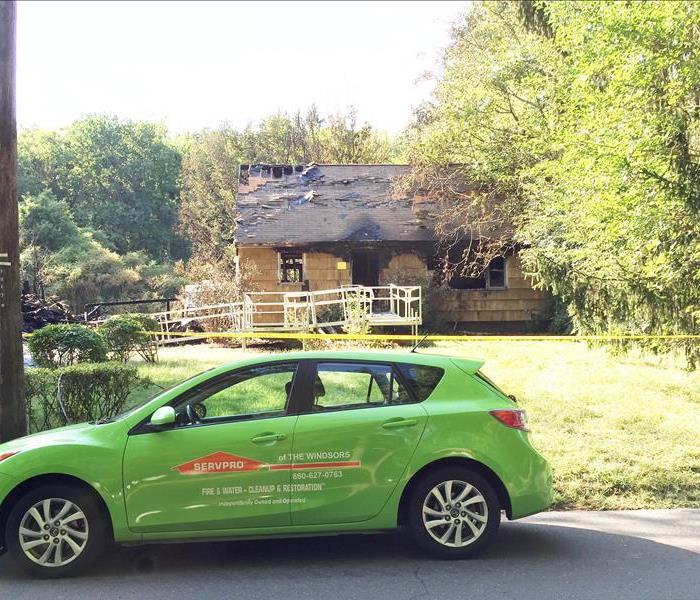 This picture shows an actual house fire in Windsor, CT. that SERVPRO of The Windsors is helping the homeowner with.
This picture shows an actual house fire in Windsor, CT. that SERVPRO of The Windsors is helping the homeowner with.
SERVPRO is a proud partner with the American Red Cross. The American Red Cross is a great program that continuously responds to disasters and emergencies. This October we continue our partnership to help families prevent, prepare for, and recover from disasters. The “Red Cross and the community partners have already saved at least 111 lives, and have made at-risk communities from coast-to-coast stronger and safer by installing more than 473,000 smoke alarms, replacing more than 32,000 batteries and creating nearly 170,000 escape plans."
When thinking about fire safety there are some alarming statistics. Did you know that home fires are actually the majority of the disasters that occur? On average, 36 people suffer injuries as a result of home fires every day. Over $7 billion in property damage occurs every year due to home fires. 52% of parents with children ages 3-17 have not talked to their families about fire safety and
Fire prevention week is October 9th-15th this year, this is a great time to inspect your home and prepare you family for a potential fire. Here are the three things you can do to protect your family:
- Check your smoke alarms regularly
- Practice fire drills at home
- Route an escape plan
While we hope for the best, we have to prepare for the worst. While we want all the member of our community to be safe, should disaster strike we are #heretohelp!
Here to Help!
5/10/2016 (Permalink)
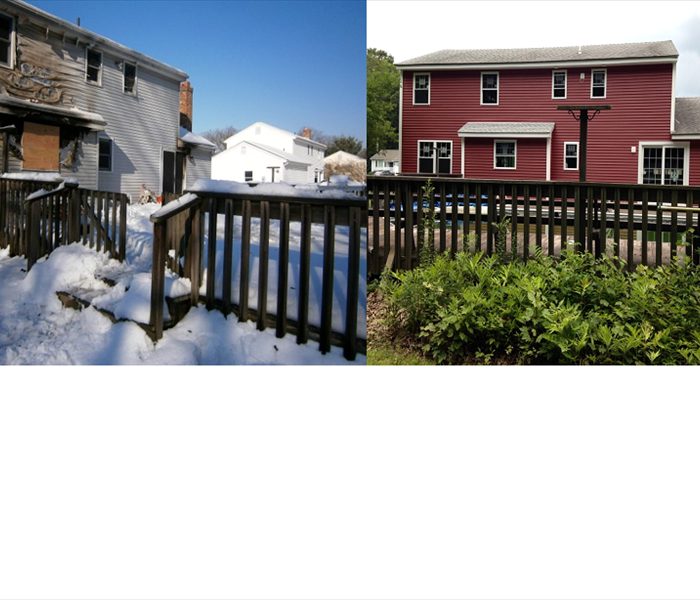 This picture shows the exterior of a home our company helped to rebuild after a fire in South Windsor, CT
This picture shows the exterior of a home our company helped to rebuild after a fire in South Windsor, CT
Fires are especially devastating. After a fire, your property will likely suffer from not only fire and smoke damage, but also widespread water damage and flooding from firefighting efforts. We understand this is a difficult time.
We’re here to help.
We can help alleviate the stress of the claims process. SERVPRO of The Windsors has specialized fire and water damage restoration training and experience. We are the leader in the restoration industry and our professionals are available 24/7. As a national brand we have relationships with most insurance companies to ensure you receive excellent service.
Beginning with a thorough assessment of your home and belongings to negotiating with your insurance company, to completing the rebuild of your home we can guide you through the claims process. SERVPRO of The Windsors is a comprehensive company, our services include:
Pack-outs
Contents cleaning
Dry-cleaning
Residential cleaning
Reconstruction services
After being in the industry for over 30 years and personally experiencing a fire loss, I understand the stress and hardships of suffering from a fire. If any questions or obstacles arise I am available to assist in any way possible. I have included my direct number below; please feel free to call me directly with any questions or to schedule a no-obligation consultation; I’ll be happy to share my expertise with you.
Regards,
Antonio Senese






 24/7 Emergency Service
24/7 Emergency Service
















